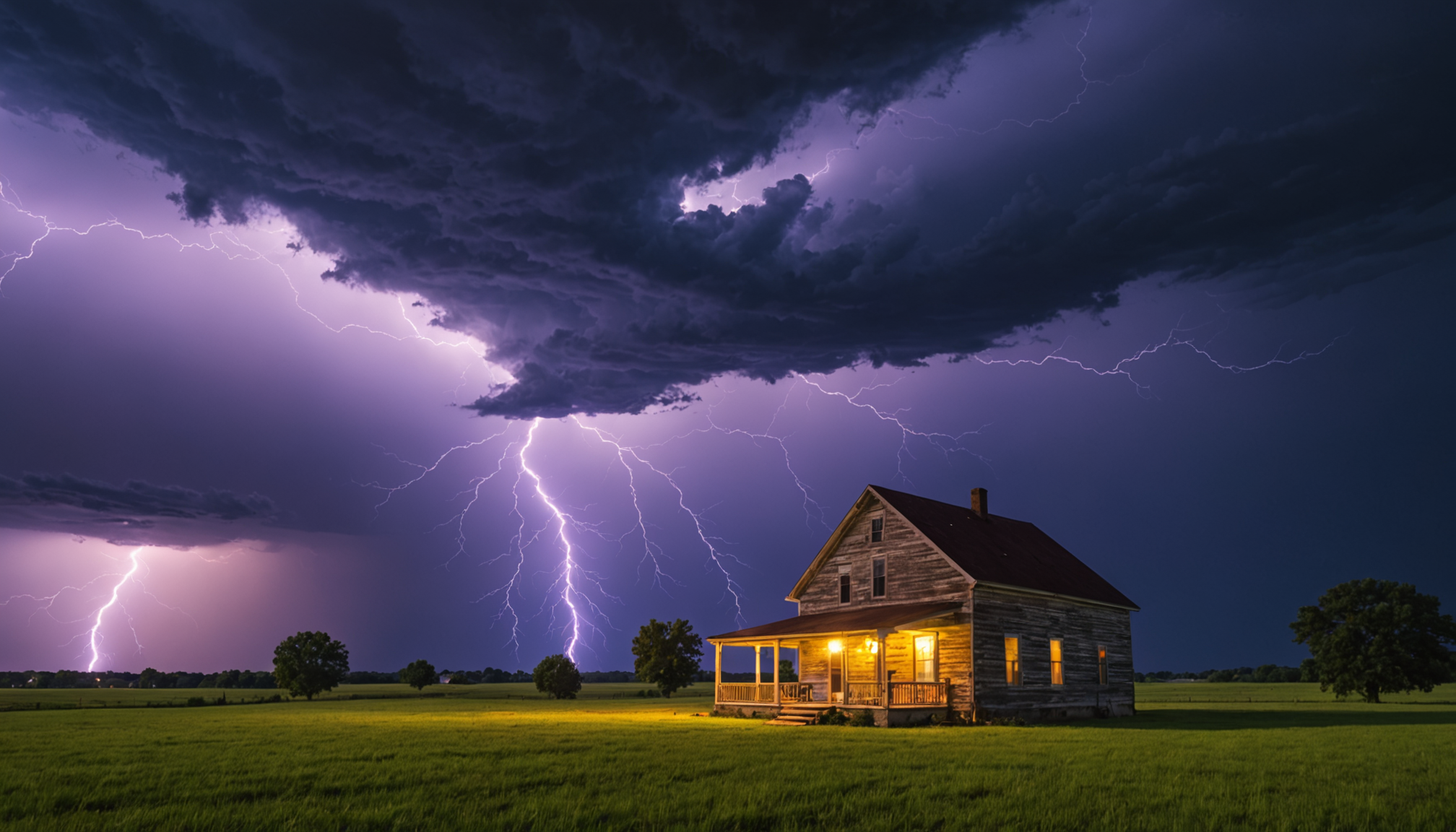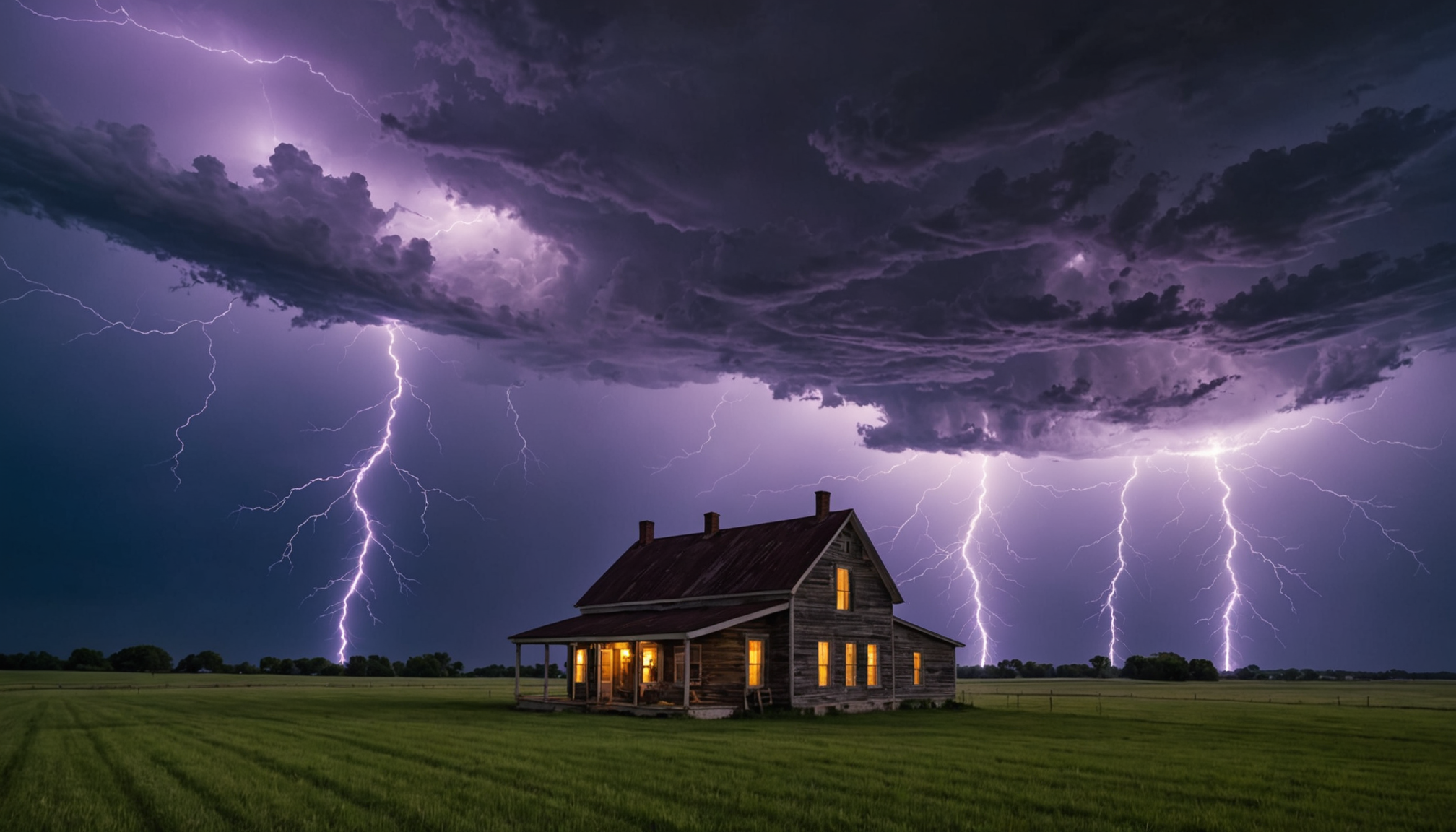Missouri’s unique climate and geographical location make it particularly susceptible to frequent and severe thunderstorms. As residents know, these storms can bring dramatic lightning displays, which, while captivating, pose significant risks to homes across the state. Understanding these risks is crucial for homeowners wanting to protect their families and properties from potential harm and damage caused by lightning strikes.
The electrical havoc that a single lightning strike can unleash is both immediate and far-reaching. Each bolt can pack a punch of up to 120 million volts, enough to irreparably damage your home’s electrical appliances and infrastructure. In 2020 alone, the National Fire Protection Association (NFPA) reported that home fires caused by lightning led to an estimated $451 million in direct property damage across the United States. Augmenting the vulnerability, Missouri’s position in the country’s central storm corridor, commonly known as Tornado Alley, means that homes are routinely exposed, increasing the probability of lightning strikes compared to states outside this zone.
Besides the direct risks to life and property, indirect effects must not be overlooked. A strike can create electrical surges that travel through power lines, plumbing, and even phone lines, affecting the home’s entire electrical system. Surge protection devices are essential to safeguarding sensitive electronics and appliances from this threat. The Insurance Information Institute also emphasizes that lightning rods and grounding systems, which safely redirect the energy into the earth, are critical investments for any Missouri homeowner. Therefore, understanding and mitigating these risks using comprehensive lightning protection systems is not just advisable but necessary to prevent accidents, downtime, and costly repairs.
Components of a lightning protection system
A comprehensive lightning protection system consists of several critical components designed to work together seamlessly to provide maximum safety for your home. At the heart of these systems are lightning rods, which are strategically placed to serve as the first point of contact for a lightning strike. These rods do not attract lightning per se; rather, they offer a preferred path for lightning to travel safely toward the ground, therefore minimizing the risk of direct strikes to the structure itself.
Connecting these rods are a series of conductive cables, which function as pathways for the electrical energy from the lightning to follow. These cables are typically made of durable materials such as copper or aluminum, chosen for their excellent conductive properties. The cables direct the electrical current away from the building and into the earth, where it can dissipate without posing a threat to the home’s structural integrity.
A lightning protection system also includes grounding rods, which are essential for effectively channeling the electrical energy into the ground. These rods are buried deep in the soil and connected to the conductor cables, ensuring the discharge is safely absorbed by the earth. The grounding system’s effectiveness depends largely on proper installation, often requiring professional assessment to ensure that it matches the soil conductivity characteristics specific to a Missouri home’s location.
Alongside these components, surge protection devices play a vital role in safeguarding a home’s electrical system. These devices, installed at the primary electrical panel and at critical points of usage, prevent power surges caused by lightning strikes from damaging home electronics and appliances by redirecting or blocking excess voltage. A thorough surge protection strategy should include both a whole-house surge protector and individual point-of-use protectors for sensitive electronics.
Homeowners in Missouri must consider these components as part of an integrated strategy to protect their homes from the frequent lightning activity characteristic of the region. Engaging professional services ensures that these systems are appropriately designed and installed to meet local conditions and regulatory requirements, thus maximizing protection and providing peace of mind.
- Lightning rods provide a safe path for lightning, preventing direct strikes to the building itself.
- Conductive cables, usually made of copper or aluminum, connect lightning rods to grounding rods, facilitating safe energy dissipation.
- Properly installed grounding rods ensure that electrical energy is effectively channeled into the earth.
- Surge protection devices are essential to prevent lightning-induced power surges from damaging home electronics.
- Professional installation tailored to Missouri’s specific soil and climate conditions enhances the effectiveness of these systems.
Installation process and considerations
Many homeowners in Missouri misunderstand critical aspects of installing lightning protection systems, which can lead to ineffective setups and increased vulnerability during severe weather events. One common mistake involves improper placement of lightning rods. Some believe that placing rods only at the tallest points of a home suffices, but effective protection requires strategic placement across vulnerable areas such as chimneys, porches, and roof ridges, ensuring any part of the structure is safely within the zone of protection.
Additionally, insufficient attention to the quality of materials used, such as conductive cables, can undermine the entire system. Opting for inferior or inappropriate materials, which may not handle lightning’s immense electrical charge, increases the risk of system failure. It’s crucial to use high-quality, durable materials like copper or aluminum, ensuring they are correctly sized and securely connected to handle the electricity safely.
Another frequent oversight is inadequate grounding. Some homeowners attempt to install grounding rods themselves, leading to improper depth or placement, particularly in Missouri’s diverse soil types. An effective grounding system must be buried deep enough and positioned correctly according to local soil conductivity to efficiently direct the energy into the ground. Professional assessment and installation are advisable to match these requirements accurately.
Ignoring surge protection also constitutes a significant error. Even with a functional lightning protection system, electrical surges can still infiltrate a home’s circuitry and damage appliances. Homeowners may falsely believe that point-of-use surge protectors, like power strips, are sufficient. Instead, incorporating comprehensive surge protection, including a whole-house system at the electrical panel, alongside individual device protection, is essential to cushion against internal damage.
Lastly, failing to obtain professional installation or skipping a review by certified personnel leads to systems that could be incorrectly sized or poorly configured. Experts ensure that all components align with local building codes and safety standards, taking into account Missouri’s specific climatic conditions and soil characteristics.
To avoid these pitfalls, hiring qualified professionals to assess, install, and maintain your lightning protection system guarantees optimum performance. Investing in expert advice and quality components results in a reliable barrier against Missouri’s frequent lightning threats, protecting your home and offering peace of mind.
Maintenance and inspection guidelines
A reliable lightning protection system requires regular maintenance and inspections to ensure its continued effectiveness in safeguarding Missouri homes from lightning strikes. While the system components are designed with durability in mind, neglecting routine checks can compromise their functionality and, ultimately, the safety of your home.
Begin by scheduling regular visual inspections of the entire system, at least once a year, and after significant weather events. Pay close attention to the lightning rods, ensuring they remain securely fastened and free of corrosion. Over time, exposure to the elements can weaken physical connections, making them less effective in directing electrical energy safely into the ground. Similarly, inspect conductive cables for any signs of wear, fraying, or damage. These cables, which should be made of high-quality copper or aluminum, are critical for managing the immense electrical charge associated with lightning, and compromised cables may result in dangerous power surges.
The grounding system also demands thorough examination. Verify that grounding rods are firmly entrenched in the soil and have not shifted or become exposed. Given Missouri’s varying soil conductivity, it’s vital that grounding systems are appropriately adapted to local conditions, a task that often requires professional assessment. An expert can measure soil resistance and confirm that the grounding system performs optimally.
Surge protection devices should not be overlooked during maintenance routines. Confirm that whole-house surge protectors at the primary electrical panel are functioning as intended. These devices act as your home’s frontline defense against lightning-induced power surges, and failure here can lead to costly damage to electronics and appliances. Checking these devices for wear and functionality ensures that your home’s interior remains shielded against electrical disturbances.
Documenting maintenance activities and creating an organized log of inspections and any repairs made will aid in identifying potential issues before they become serious problems. This record-keeping can also be invaluable when consulting professionals or filing insurance claims, providing a history of your adherence to best practices in home protection.
As a homeowner in Missouri, taking proactive steps to maintain your lightning protection system can save you from potential heartbreak and extensive financial loss. Regular maintenance, coupled with professional inspections, ensures every component of the system continues to perform at its best. By committing to this vigilance, you’ll not only preserve the integrity of your home but also uphold a safe, secure environment for your family. Remember, safeguarding your home from Missouri’s frequent lightning activity isn’t just a precaution—it’s a responsibility—one that empowers you to protect your most valued assets with confidence.
Benefits of investing in lightning protection
- Why is lightning protection so important for homes in Missouri?
- Missouri is located in a region prone to frequent and severe thunderstorms, making homes more susceptible to lightning strikes. Investing in lightning protection systems mitigates risks by directing lightning safely into the ground, protecting your home’s structure and electrical systems from damage.
- What components are typically included in a lightning protection system?
- A comprehensive lightning protection system includes lightning rods, conductive cables, grounding rods, and surge protection devices. These components work together to safely direct electrical energy from a lightning strike into the earth, safeguarding the home from structural and electrical damage.
- How often should a lightning protection system be inspected?
- A lightning protection system should be inspected at least once a year and after any significant weather events. Regular inspections ensure that all components, including lightning rods, cables, and grounding systems, are in optimal condition and provide effective protection for your home.
- Is professional installation necessary for a lightning protection system?
- Yes, professional installation is essential to ensure the system is tailored to your home’s specific needs and local conditions in Missouri. Professionals ensure that components are correctly installed and comply with safety standards, maximizing the system’s effectiveness.
- Can surge protection devices alone provide adequate protection during lightning storms?
- While surge protection devices are crucial for safeguarding your home’s electrical appliances, they are not a substitute for a full lightning protection system. These devices are part of a broader strategy to protect homes by complementing lightning rods and grounding systems to mitigate lightning risks effectively.

